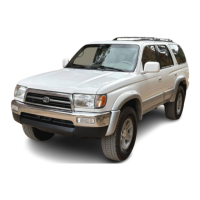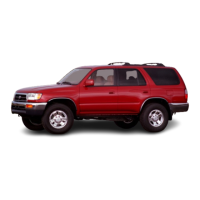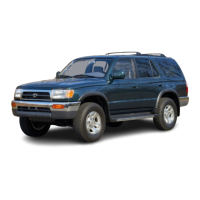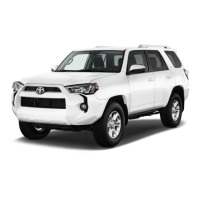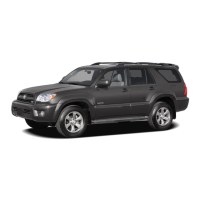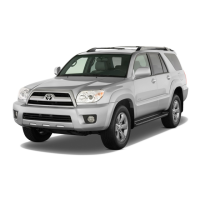Do you have a question about the Toyota 4Runner 1999 and is the answer not in the manual?
Explains CAUTION and NOTICE warnings used in the manual for safety and vehicle protection.
Provides an overview of the vehicle's instruments and controls, including the instrument cluster.
Explains the meaning of various warning and indicator lights found on the dashboard.
Covers the operation and features related to vehicle keys and door access.
Explains the theft prevention system and its indicator light for vehicle security.
Covers adjustments and safety features for seats, seat belts, steering wheel, and mirrors.
Urges proper use of seat belts and outlines precautions for various occupants.
Explains the function of SRS airbags as supplemental protection during impacts.
Covers the operation of vehicle lights, wipers, and defogger systems.
Explains how to operate headlights, high/low beams, and turn signals.
Covers the operation of windshield wipers and washer fluid, including intermittent settings.
Explains the function of various gauges, meters, and reminder indicators.
Describes the operation and interpretation of the fuel gauge and low fuel warning light.
Lists various indicators and buzzers and explains their meanings for vehicle status.
Covers the ignition switch, transmission operation, and parking brake.
Details the operation of the automatic transmission, including shifting and driving modes.
Covers the operation of the four-wheel drive system and its transfer modes.
Provides instructions for operating a manual transmission, including shifting speeds.
Details how to set and release the parking brake and its reminder light.
Explains how to operate the cruise control system for maintaining speed.
Covers the car audio system and air conditioning controls.
Details the controls for the type 1 air conditioning system.
Describes the specific buttons, controls, and features of the audio system.
Details the controls for the type 2 air conditioning system.
Covers various other equipment and features of the vehicle.
Explains how to set and use the digital clock.
Provides safety precautions for driving the vehicle off-road.
Offers tips for the initial break-in period to ensure vehicle longevity and economy.
Specifies the type of fuel to use and fuel tank capacity.
Explains the function and maintenance of the three-way catalytic converter.
Describes the hydraulic brake system, including tandem master cylinder and brake booster.
Discusses summer tires and all-season tires, their suitability, and limitations.
Lists checks to perform before entering and starting the vehicle.
Provides procedures for starting the engine in manual and automatic transmissions.
Offers advice for driving in different conditions like crosswinds and hills.
Covers trailer towing, weight limits, hitches, and safety chains.
Offers tips on saving fuel and maintaining the vehicle for longevity.
Provides simple checks and procedures for when the vehicle fails to start.
Guides on how to react and restart the engine if it stalls while driving.
Details steps to take if the engine overheats, including safety precautions.
Provides instructions for changing a flat tire, including safety and tool usage.
Provides detailed instructions and safety precautions for jump-starting a vehicle.
Outlines recommended towing methods and precautions for two-wheel drive models.
Explains the importance of regular maintenance for vehicle longevity and performance.
Provides guidelines for preventing vehicle corrosion, especially in harsh environments.
Offers advice on frequent washing to maintain paint and body condition.
Provides instructions for cleaning various interior components like vinyl, carpets, and controls.
Introduces the do-it-yourself maintenance section, covering engine overview, fuses, and precautions.
Outlines safety precautions for performing vehicle maintenance.
Covers essential checks and maintenance for the engine and chassis.
Explains how to check the engine oil level and add oil if necessary.
Emphasizes the importance of proper tire pressure for safety, handling, and tire life.
Covers checks and maintenance for electrical components, focusing on the battery.
Outlines precautions for checking battery condition and handling potential hazards.
Explains how to check and replace blown fuses, including fuse types and ratings.
Provides detailed dimensions and weight specifications for different tire and opening extension configurations.
Lists engine models, types, bore, stroke, and displacement.
Specifies fuel type, octane rating, and tank capacity.
Provides tire sizes, pressure specifications, and wheel nut torque.
Guides owners on how to report vehicle safety defects to NHTSA and Toyota.
Explains DOT quality grades: Treadwear, Traction, and Temperature ratings.
Explains CAUTION and NOTICE warnings used in the manual for safety and vehicle protection.
Provides an overview of the vehicle's instruments and controls, including the instrument cluster.
Explains the meaning of various warning and indicator lights found on the dashboard.
Covers the operation and features related to vehicle keys and door access.
Explains the theft prevention system and its indicator light for vehicle security.
Covers adjustments and safety features for seats, seat belts, steering wheel, and mirrors.
Urges proper use of seat belts and outlines precautions for various occupants.
Explains the function of SRS airbags as supplemental protection during impacts.
Covers the operation of vehicle lights, wipers, and defogger systems.
Explains how to operate headlights, high/low beams, and turn signals.
Covers the operation of windshield wipers and washer fluid, including intermittent settings.
Explains the function of various gauges, meters, and reminder indicators.
Describes the operation and interpretation of the fuel gauge and low fuel warning light.
Lists various indicators and buzzers and explains their meanings for vehicle status.
Covers the ignition switch, transmission operation, and parking brake.
Details the operation of the automatic transmission, including shifting and driving modes.
Covers the operation of the four-wheel drive system and its transfer modes.
Provides instructions for operating a manual transmission, including shifting speeds.
Details how to set and release the parking brake and its reminder light.
Explains how to operate the cruise control system for maintaining speed.
Covers the car audio system and air conditioning controls.
Details the controls for the type 1 air conditioning system.
Describes the specific buttons, controls, and features of the audio system.
Details the controls for the type 2 air conditioning system.
Covers various other equipment and features of the vehicle.
Explains how to set and use the digital clock.
Provides safety precautions for driving the vehicle off-road.
Offers tips for the initial break-in period to ensure vehicle longevity and economy.
Specifies the type of fuel to use and fuel tank capacity.
Explains the function and maintenance of the three-way catalytic converter.
Describes the hydraulic brake system, including tandem master cylinder and brake booster.
Discusses summer tires and all-season tires, their suitability, and limitations.
Lists checks to perform before entering and starting the vehicle.
Provides procedures for starting the engine in manual and automatic transmissions.
Offers advice for driving in different conditions like crosswinds and hills.
Covers trailer towing, weight limits, hitches, and safety chains.
Offers tips on saving fuel and maintaining the vehicle for longevity.
Provides simple checks and procedures for when the vehicle fails to start.
Guides on how to react and restart the engine if it stalls while driving.
Details steps to take if the engine overheats, including safety precautions.
Provides instructions for changing a flat tire, including safety and tool usage.
Provides detailed instructions and safety precautions for jump-starting a vehicle.
Outlines recommended towing methods and precautions for two-wheel drive models.
Explains the importance of regular maintenance for vehicle longevity and performance.
Provides guidelines for preventing vehicle corrosion, especially in harsh environments.
Offers advice on frequent washing to maintain paint and body condition.
Provides instructions for cleaning various interior components like vinyl, carpets, and controls.
Introduces the do-it-yourself maintenance section, covering engine overview, fuses, and precautions.
Outlines safety precautions for performing vehicle maintenance.
Covers essential checks and maintenance for the engine and chassis.
Explains how to check the engine oil level and add oil if necessary.
Emphasizes the importance of proper tire pressure for safety, handling, and tire life.
Covers checks and maintenance for electrical components, focusing on the battery.
Outlines precautions for checking battery condition and handling potential hazards.
Explains how to check and replace blown fuses, including fuse types and ratings.
Provides detailed dimensions and weight specifications for different tire and opening extension configurations.
Lists engine models, types, bore, stroke, and displacement.
Specifies fuel type, octane rating, and tank capacity.
Provides tire sizes, pressure specifications, and wheel nut torque.
Guides owners on how to report vehicle safety defects to NHTSA and Toyota.
Explains DOT quality grades: Treadwear, Traction, and Temperature ratings.
| Brand | Toyota |
|---|---|
| Model | 4Runner 1999 |
| Category | Automobile |
| Language | English |
